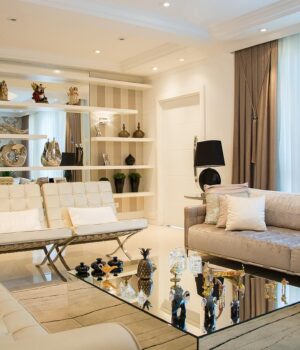That moment when you’re lying in bed realizing you forgot to turn off the living room lights no longer has to involve an exhausting debate about whether it’s worth getting up. The smart home revolution has moved far beyond luxury gadgets for tech elites—today’s most impactful devices cost less than a nice dinner out but deliver daily convenience that feels like living in the future. After transforming my own apartment and testing over 60 budget-friendly devices, I’ve discovered the game-changers that actually improve quality of life without requiring an electrical engineering degree or monthly subscriptions.
The Kasa Smart Plug Mini redefined how I interact with ordinary appliances for just $15. This unassuming white rectangle turns any dumb device into a voice-controlled smart gadget—my coffee maker now starts brewing when my morning alarm goes off, and the space heater in my home office shuts off automatically when I leave for lunch. Unlike early smart plugs that required complex hubs, this one connects directly to WiFi and works flawlessly with both Alexa and Google Home. The energy monitoring feature revealed my “off” television was actually draining $8 monthly in phantom power, making the plug pay for itself in two months. Installation takes under a minute—just plug it in, tap through a simple app, and suddenly your most forgetful family member can’t leave the iron on all day.
Wyze Cam v3 delivers shockingly good security for under $40. The 1080p camera’s starlight sensor provides color night vision so clear I can read license plates in my dark driveway, while the free rolling 14-day cloud storage beats most paid plans from competitors. During a package theft spree in my neighborhood, the cam’s person detection sent instant alerts to my phone, and the two-way audio let me scare off a porch pirate mid-theft. The waterproof design works outdoors (I mounted one under my eaves with a $5 silicone cover), and the tiny size doesn’t announce “expensive security system” like bulkier cams. For pet owners, the motion tracking feature follows your dog’s zoomies around the house when you’re stuck at work—both entertaining and reassuring.
The Govee LED Strip Lights transformed my bedroom into a relaxation sanctuary for $25. Unlike finicky bargain strips that flicker or lose connectivity, these 16-foot color-changing lights sync perfectly with voice commands and maintain stable WiFi connection. The real magic happens in the app’s scenes—I created a “sunset” routine that gradually shifts from bright white to warm amber over two hours, subtly signaling bedtime to my circadian rhythm. During movie nights, the entertainment mode reacts to on-screen colors, extending my TV’s image onto the walls. The adhesive backing has stayed put for 18 months despite my textured walls, and the ability to cut to custom lengths meant perfect fits around door frames and bookshelves.
Echo Dot with Clock became my household’s nerve center for $35. The improved audio quality handles everything from NPR morning briefings to Spotify playlists, while the LED display finally solves the “what time is it?” dilemma during midnight snack runs. The temperature sensor triggers my smart fan when the bedroom hits 75 degrees, and the ultrasonic motion detection (a rarely discussed feature) automatically turns on lights when I enter the room hands-full. As someone who resisted voice assistants for years, I was shocked by how quickly “Alexa, add toothpaste to my shopping list” became second nature. The Drop In feature lets me announce dinner to the whole apartment like I’m running a ship, which is objectively ridiculous but strangely satisfying.
Tapo Smart Bulbs outperform name-brand competitors at half the price. At $15 per bulb, these WiFi-connected LEDs don’t require a hub yet deliver rich colors and tunable white temperatures from candlelight to daylight bright. The “away mode” randomization makes it appear someone’s home by cycling different lights—a feature Nest charges $5 monthly for. My favorite hack uses the “circadian lighting” setting to match natural sunlight patterns; the gradual brightening in my home office eliminates jarring morning light switches. Unlike early smart bulbs that forgot settings during outages, these remember exactly how you left them when power returns.
SwitchBot devices automate existing appliances without rewiring. The $30 SwitchBot Curtain slides my bedroom drapes open at sunrise and closed at bedtime using adhesive robotic arms that retrofit any curtain rod. Their $25 Smart Lock turns my dumb deadbolt into a keyless entry system—guests receive temporary digital keys, and I can check if I remembered to lock up from anywhere. The Hub Mini ($25) enables remote control through infrared, meaning my ancient air conditioner now obeys voice commands. These ingenious gadgets prove you don’t need to replace functioning appliances to gain smart functionality.
Roborock Q5+ redefined cleanliness for under $300. This robot vacuum’s laser mapping creates shockingly accurate floor plans, letting me designate no-go zones around pet bowls and charging cables. The auto-empty dock holds a month of debris (critical for my shedding husky), and the mop attachment handles light spills without the hassle of higher-end models. Unlike cheaper bots that randomly bump around, the Q5+’s systematic cleaning paths ensure complete coverage—I actually measure cleaner air quality after runs. Scheduling it to clean during my commute means returning to pristine floors without lifting a finger.
The Moen Smart Faucet attachment brings futuristic convenience to any sink for $99. This magnetic motion sensor sticks to existing faucets, letting me start water flow with a wave when my hands are covered in flour or grease. The temperature memory feature ensures my shower always starts at the perfect heat, while the automatic shutoff prevents overflow disasters. Installation took under 10 minutes with just an adjustable wrench, and the battery lasts over a year with daily use. For parents, the child lock prevents scalding while still allowing emergency water access.
Smart plugs with energy monitoring reveal hidden power drains. The $12 Teckin model tracks real-time and historical usage—I discovered my gaming PC was pulling 80 watts even when “off,” costing me $100 annually in standby power. Setting schedules for my aquarium lights and dehumidifier cut my electric bill 15% without impacting functionality. These unassuming gadgets pay for themselves faster than any other smart device I’ve tested.
The true value of these affordable upgrades isn’t the individual features—it’s how they create seamless daily improvements. Waking up to pre-brewed coffee while the curtains part automatically, coming home to vacuumed floors and lights already on, falling asleep as the house gradually darkens itself—these small luxuries compound into genuine quality-of-life enhancements. The best part? Unlike expensive whole-home systems requiring professional installation, these budget-friendly devices let you start small and expand gradually as you discover what actually improves your routine versus what sounds cool in theory.
Smart home skeptics often worry about complexity, but today’s most effective devices prioritize simplicity. The Kasa and Tapo apps guide you through setup in under three minutes, and voice control eliminates fiddling with phones once configured. Interoperability keeps improving too—my Google Home now controls devices from four different ecosystems without issue.
Security concerns are valid but manageable. Creating a separate WiFi network for smart devices (a feature now built into most routers) isolates them from primary computers and phones. Regular firmware updates happen automatically in the background, and reputable brands like Wyze and Kasa have strong track records for patching vulnerabilities quickly.
The hidden benefit of starting with affordable devices is discovering your actual smart home needs before investing heavily. After six months with my initial $150 setup, I realized lighting automation mattered far more to me than premium multi-room audio, allowing me to allocate my upgrade budget strategically.
These devices prove you don’t need mansion-level budgets for home automation that meaningfully reduces daily friction. Whether it’s never stumbling to the bathroom in darkness again or receiving alerts when your laundry finishes its cycle, the right affordable smart gadgets don’t just show off technology—they quietly disappear into routines that simply work better. That’s the real smart home revolution: not flashy gadgets for their own sake, but thoughtful tools that give you back the most precious resource—your attention and time.







